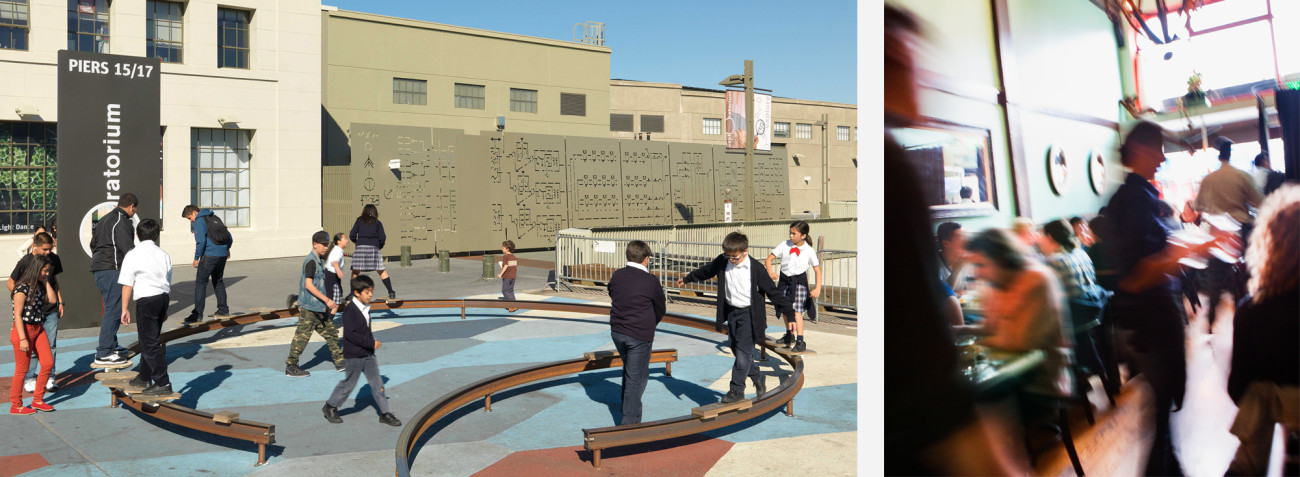Long after the America’s Cup has come and gone, the new home of San Francisco’s Exploratorium will be drawing crowds to the city’s northeast waterfront. The museum’s $218 million construction and move from the Palace of Fine Arts to piers 15 and 17 comes with a mission not just to educate and enlighten the public, but to reinvigorate the long-dormant stretch between the wildly successful Ferry Plaza to the south and the waterfront tourist standby, Pier 39, to the northwest.
“We end up becoming the anchor in the middle that I think will really traffic and populate the space from the Ferry Building all the way up,” said Dennis Bartels, executive director of the museum. “The city is finally rediscovering its waterfront.”
The museum has been looking for room to grow for years. It considered a site at The Embarcadero and Bay Street in 2004. But the fit wasn’t right, Bartels said. When officials at the Port of San Francisco suggested the Exploratorium search team check out the piers, it was love at first sight. “The reaction was all the same,” Bartels said. “This is it!”
Working with a tangle of public agencies, all responsible for the various aspects of waterfront development, the museum and San Francisco’s EHDD Architecture came up with a plan. They hope that the 230,000 square-foot indoor and outdoor complex becomes a truly inviting and buzzworthy social hub.
Even before the project opens, it is expected to have a positive impact on the northeast waterfront. Consultancy BAE Urban Economics anticipates that construction on the piers will engage 900 workers both directly and indirectly during the estimated two years of construction. The group anticipates a $300 million short-term regional gain during building, a $28 million increase in long-term annual economic impact and $1.4 million annually in net new total tax revenue for the city and state.
Ultimately, Bartels hopes that the project helps create sufficient demand to drive an even more robust public transportation system on the waterfront, with as much as five times the current number of MUNI trains running along the Embarcadero. While the new location is already at a transit hub, more transit service should improve accessibility and enhance the museum’s educational impact on teachers, kids and the community, Bartels said.
The museum focuses on science, art and human perception and uses its $35.5 million annual budget to offer professional development to 400 teachers each year and to host an ever-growing list of original, interactive exhibits, displays and artworks intended to nurture human curiosity.
At its current location, 544,000 people a year visit the Exploratorium, with about 61 percent of those visitors hailing from the Bay Area. Nearly 19 million people pass the Exploratorium’s future home each year, Bartels estimates, based on visitor counts to Fisherman’s Wharf and the Ferry Building. The museum plans to draw in as many of those passerby as possible – an estimated 800,000 paying visitors a year.
Development along the Embarcadero has been a boon for San Francisco over the past decade. Businesses along the Embarcadero have increased their sales over 6.9 times since 1995 and more than doubled their share of city sales tax payments during that time, according to data from Ted Egan, chief economist in San Francisco’s Office of Economic Analysis.
With more than 8,000 square feet of income-generating space, including a bayside restaurant and café, as well as a publicly accessible Exploratorium store, the new museum will certainly add to that.
Marc L’Italien, EHDD’s principal architect for the project, says he anticipates a hum of activity from the project driven by revitalization, in much the same sense as that which has occurred at the Ferry Building. “It was always there, but it took someone to come in and have a vision for how it could be transformed,” said L’Italien. “It just had to be looked at in a different way, and look what it has become.
His plans for the new museum include an interior area inviting the public to view part of the museum without buying a ticket as well as a glass-enclosed observatory at the end of Pier 15, an outdoor terrace, and public-access areas that should create a permeable, accessible space to invite the public in and create a node of activity.
An additional attraction to the site could be its green credentials. The Exploratorium’s goal is to be a LEED Gold, net-zero-energy facility, possibly the largest net-zero-energy museum of its size in the world. The museum will run a 1.4-megawatt photovoltaic system on the roof to meet 100 percent of its electricity needs. It also plans to leverage its location by pumping bay water through a maze of pipes under its poured concrete floor to cool or heat its interior.
The project will be built in two phases, with Pier 17, the third-oldest pier on the San Francisco waterfront, slated for development in the second phase. At about 110,000 square feet, it will provide 2.5 additional acres for future expansion.
“There’s a lot of potential,” says L’Italien. “This site has been one of the biggest inspirations in this whole process.”
“What a gift!” he said.
Read the original story here.
